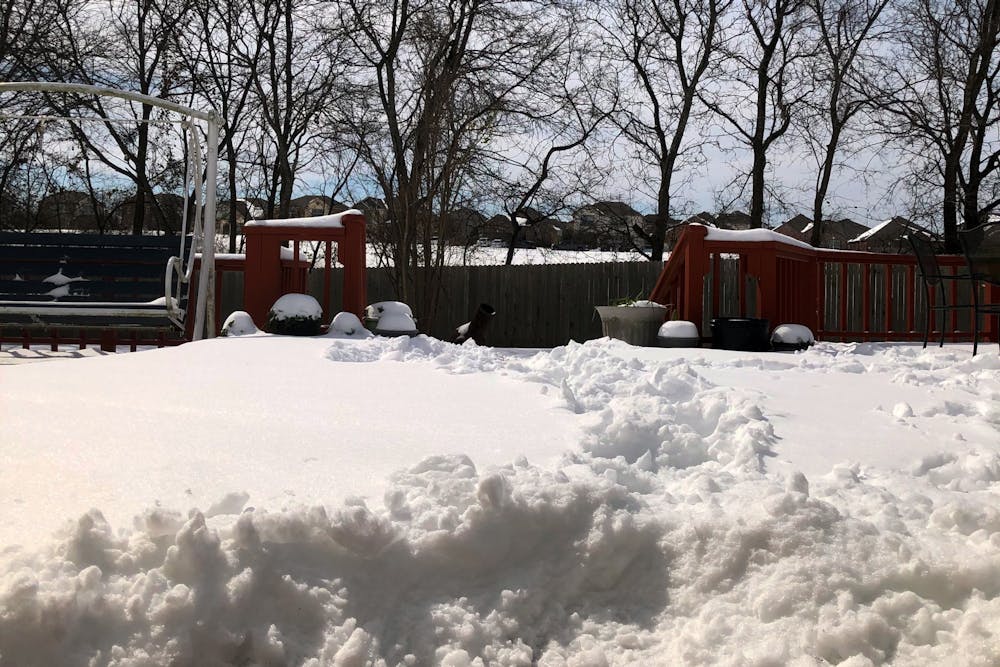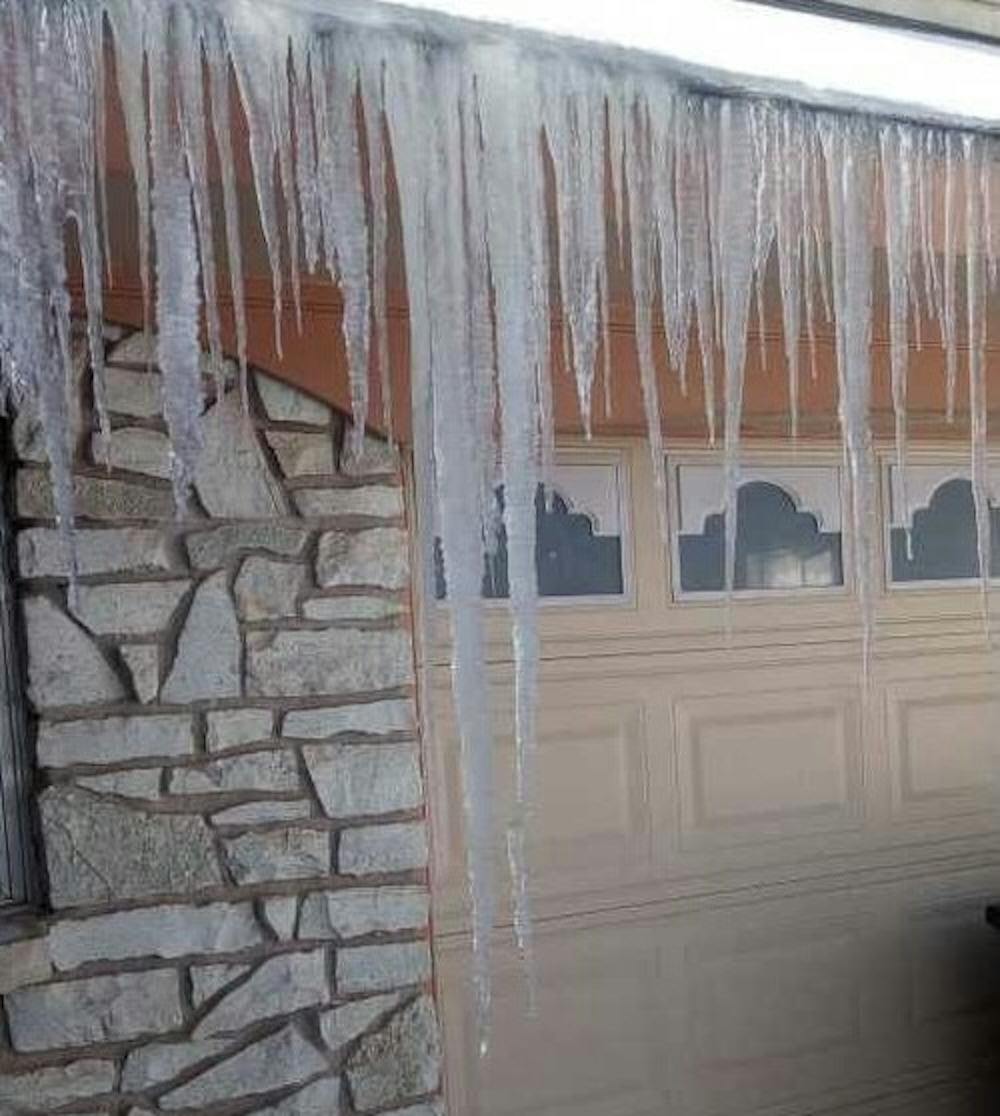
College junior Brian Vu learned how to turn on the fireplace in his house to stay warm after the heat dropped from 78 to 53 degrees inside and the snowfall increased. (Photo from Brian Vu)
Wharton and Engineering junior Effie Guo was completing a problem set for ESE 501: "Networking - Theory and Fundamentals" from her home in Dallas when the lights in her room suddenly flickered, and her power went out in the early morning on Feb. 14.
After three days of completing assignments in freezing temperatures with no power, electricity finally returned on the evening of Feb. 17. A pipe burst shortly after, filling a bathroom and bedroom in her house with half an inch of murky water — forcing her to put her studies on hold yet again.
The winter storms across large parts of the Central and Southern United States have hit Texas and Oklahoma with high levels of snow and unusually cold temperatures, causing widespread flooding and power outages. More than 14 million Texans lost access to clean, safe water, and 4 million people lost electricity. Temperatures began to fall on Feb. 14, and much of the state was hit with rolling power outages early the next morning. There are currently over 6,000 households without power across the state.
Despite Penn inviting students back to campus this spring, some students decided to remain home for the semester. Over the past week, students living in Texas struggled to complete their assignments and midterms while enduring low temperatures and power outages.
College junior Brian Vu was looking forward to returning to campus on Feb. 15 after spending the past few months with his family in Austin, Texas. On Feb. 14 his flight was canceled, and he no longer has concrete plans to return to Philadelphia because he wants to make sure his family's living conditions are safe before he leaves.
During the three days he spent without power, Vu learned how to turn on the fireplace in his house to stay warm after the temperature dropped from 78 to 53 degrees inside and the snowfall increased. He bundled himself in five layers of clothing to go grocery shopping in the afternoon on Feb. 17.
“I went to the grocery store, and it was an apocalypse. It was like going through a maze, and the only source of light was your own dying phone’s flashlight.” Vu said. “It was very hard because we had to take pictures of all the barcodes [for items you wanted to purchase]."
On Feb. 15, College junior Emma Arsekin was writing a midterm essay for PSCI 217: "Russian Politics" that was due at midnight the next day. When the lights flickered off in her Houston home at 2 a.m. she repeatedly refreshed the internet before realizing that the power went out. Arsekin emailed her professor from her phone, describing her situation and asking for an extension on the paper. Her power finally returned 62 hours later, and she submitted the essay on Feb. 18.
“It was difficult because my house had gone to 10 degrees that night, so [my family and I] camped out in the living room, but that meant I couldn’t get enough sleep,” Arsekin said.
Texas was hit particularly hard by power outages because the state's electrical grid operates independently, as the state dodged federal regulation that is part of regional power grids, barring it from borrowing from local grids when there are outages.
Even though Texans knew the storm was coming, Engineering sophomore Janavi Chadha said they were ill-equipped to face the dire situation when it arrived. Chadha said that milk and other food items in her refrigerator began to spoil after two days with intermittent power, and it was difficult to buy more food, as the aisles in local Dallas grocery stores were barren.
“The shelves were empty, and it felt just like when the pandemic had started — when people kept buying toilet paper,” Chadha said. “The stores were running out of flour, sugar, and milk, and the basics."
The storm only exacerbated issues for low-income families who had already been struggling due to the economic fallout from COVID-19.
College junior Laura Dees, a first-generation, low-income student who is currently residing in Harnwell College House, received a text message from her brother showing a 3-foot-long icicle that hung from the roof of their house in Bethany, Okla. for the first time on Feb. 18. She said her mother experienced the coldest day of her life with negative 22-degree windchills.

College junior Laura Dees received a text message from her brother showing a 3-foot-long icicle that hung from the roof of their house in Bethany, Okla. on Feb. 18. (Photo from Lauren Dees)
Dees said the storm posed a greater challenge for her family compared to others because of their low-income background.
“It’s really hard because we are a working-class family, and my father doesn’t have a fixed income, so my dad was unable to work at all [during the storm], and they had to spend their extra money they saved to pay off some bills on space heaters,” Dees said. “Now all of their savings have been destroyed.”
Student Financial Services reached out to students from Texas, encouraging students to contact them if their family's financial circumstances changed as a result of the storm.
College junior Calista Lopez, who is currently living in an off-campus apartment in Philadelphia, was constantly checking in with her immunocompromised mother who had trouble commuting to work from her old, poorly heated building in San Juan, Texas. Although her mother never lost power, Lopez still worried for her because she was working in the cold during the pandemic.
Chadha relied on her hotspot and the generosity of her neighbors to finish her homework, traveling to the house of one of her neighbors who had power to charge her computer and join her Zoom classes.

Chadha relied on the generosity of her neighbors who had power to charge her computer and join her Zoom classes. (Photo from Janavi Chadha)
Director of Student Life and Undergraduate Education for the School of Engineering and Applied Sciences Sonya Gwak emailed all students learning remotely from Texas on Feb. 18 to offer assistance and academic accommodations. Gwak told students to email or call her if they couldn't access course material or attend virtual classes due to the storm so she could notify faculty members about absences and help students return to academic life.
Although Chadha faced the brunt of the problems from the storm from Feb. 15 to Feb. 17, she was grateful that Gwak reached out to her with a number to call and expressed concern over her well-being.
“I’m glad they reached out eventually," Chadha said. "It was nice to know they cared about us”
Guo, Vu, and Arsekin said they are also thankful for the support they received from professors and friends during the winter storm. Vu said his friends reached out to his professors on his behalf to secure him extensions on his assignments while he was without power.
“Overall [the storm] was a pain but my attitude was just 'well what can you do?'" Arsekin said. "I was lucky to have a fireplace, bottled water, food, a car to charge my phone in, and super understanding professors, so it wasn’t nearly as bad as it could have been.”
The Daily Pennsylvanian is an independent, student-run newspaper. Please consider making a donation to support the coverage that shapes the University. Your generosity ensures a future of strong journalism at Penn.
Donate






